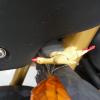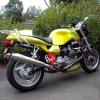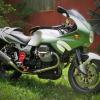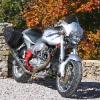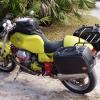Leaderboard
Popular Content
Showing content with the highest reputation on 03/17/2020 in all areas
-
3 points
-
Hi, sure, a ridiculuous amount would be nonsense and result, amongst other things, in little gas flow. Keep in mind my remarks "...Disregarding all other factors..." and "...Increasing it, within reason, ..". The ultimate goal is get as much air mass into the combustion chamber at the time it's needed and can be utilized. This is expressed as volumetric efficiency. If you have a pump (cylinder/piston) with 1l volume, the largest air volume which can be brought into the pump is 1l, which is a volumetric efficiency of 1. Now consider a combustion engine to be a flow machine. Before opening the valves the air is waiting to get into the combustion chamber. When the valves are opened it can stream into the combustion chamber. The faster the valve opens the faster it can get into the chamber. The speed of valve opening is determined by gradient of the camshaft. By increasing the valve play the controlled (and slow) ramp-up is partly skipped and the opening time (fully closed to fully opened) is shortened, the valve is actuated faster because it's already at a high gradient part of the camshaft. Hence, the air flow will increase. Decreasing the valve play would result in an earlier opening of the valves, but only a slight gap one. The air waiting to get into the combustion chamber is trickling instead of charging, overall volumetric efficiency will decrease. Hence, less air mass arrives in the combustion chamber at the end of the cycle. Having said this, this is a rather theoretical discussion because other factors, such as max. acceleration/deceleration, spring rate, weight of the moving parts of the valve train, surface pressure and so on need to be taken into account. Cheers Meinolf3 points
-
Yeah, I remember them - I HAD one! Wrecked unfortunately due to a texting teenager in her car...that’s a whole ‘nother story[emoji2959] Sent from my iPhone using Tapatalk2 points
-
Hi Kelly, valve play and timing have no connection. I've never measured AFR with a mistral crossover and oval exhaust. My setup is standard crossover and TI exhaust (which flows significantly better than the stock exhaust, but is quite loud) Again using a picture from Motoguzznix's file for visualization, the timing is dependent on the camshaft. It's best practice to adjust the point at which the intake and exhaust valve have the same lift to 2-3° before TDC and not at TDC. Or even behind, which is the reality in Guzzi engines after some time because the chain has worn a bit. The main issue with the V11 valve train are the guides, you will typical see a much larger play than factory specs after some time. So, changing the valve play versus the 0.25mm I've used will impact AFR and not timing or wear and tear. Disregarding all other factors, decreasing the play would reduce the airflow, which would lead to a richer mixture than I intended. Increasing it, within reason, would slightly improve airflow and lead to a leaner mixture. But as I wrote previously, the V11 camshaft is a good one, stay with 0.25mm. Cheers Meinolf2 points
-
Got my new LeMans badges to replace the 'Cafe Sport' badges on the carbon fiber side covers I got last week. I'll be using these on the Tenni and didn't want to remove the "Tenni" badges from the stock side covers. They are NLA. The pic of the inside shows the raised areas and the grommet/sleeved washer reinforcement that Lucky Phil was referring to concerning cracking mount points on CF covers. These covers were standard Guzzi items on the Cafe Sport. Very well made. btw, those badges are still available, unlike the early badges, and cheap at $7.20 for both2 points
-
Yep aluminium, you guys take way better images than me thats for sure but when I checked both my engines(one with and one without) thats the view I got of the ally unit and Chucks images also show the differences clearly. You can also slide a 6" steel rule into the hole and measure to the edge of the hole and see the differences in the depth as well but you need to be precise about where you take the measurements. Ciao1 point
-
Ok so here’s what I’ve got: Sure looks like an aluminum flywheel to me! Sent from my iPhone using Tapatalk1 point
-
Okay, how about the magnet test? (Not on the starter teeth, but on the side of the flywheel in front of that where the TDC marks are)....1 point
-
Pretty sure I bought it at a show - I think it was a part of a kit for an adventure bike. In my defense it was a few years ago now1 point
-
Hey Meinolf, Thank you so much for taking the time to respond with such a detailed reply, and especially how variations in the valve clearances would affect the fueling. I'll be studying this and a lot of the other material you've previously posted, I look forward to being able to get this bike tuned up and running as sweet as I can. Your generosity in sharing your knowledge and expertise, is very much appreciated. Tks Kelly1 point
-
Thanks Docc. Even though I was fearful of breaking the whole mess, I was well on my way of doing that but the bike finally restarted and ran. Glad to know it's possible to do that. (I have a feeling I'll be attempting a lot of bike "maintenance" over the next few months. You guys might be the few folks I'll be communicating to as well.)1 point
-
So I thought I'd have a play around with the throttle bodies and TPS sensor and also confirm my wiring for the PF09 TPS was correct when fitting the old style plug to the V11 loom as the colour coding is different. I made up a 5V power supply and some flying leads and confirmed the TPS read outs were correct and thought i'd do a preliminary set of the TPS which I can confirm when I power up the system on the ecu. bearing in mind that I have no idea how this engine ran or the mileage originally the TPS condition could be anything and I want to eliminate as many variables as possible. mechanically the Throttle bodies are acceptable from a wear perspective although I replaced the plastic connector rod ball assembly. Unfortunately I couldnt get the TPS reading below around 200MV unless I tapped it with a screw drive handle and then I could get it to around 140MV with the throttle blade completely closed which would work if evertime you stopped you tapped the TPS. I ran out of TPS adjustment so I decided to see if I could pull it apart and see what was happening. Although this isnt really relevant to the V11 as it uses the later TPS it might be to anyone following in my footsteps down the track. The PF09 TPS is held together with small metal press rivets so I used a box cutter blade into the joining line and gently twisted the blade to get the rivets to release. Going from one side to the other slowly slowly until I could get a 0.020" feeler gauge length ways into the gap and use those. It helps if you use one on each side simultaneously to prevent the halves rocking as it separates. The whole process took quite a while like 15 minutes but it came apart without looking like it had been apart, ie not butchered. This is the process. And this is what it looks like apart. Note the crud and rubbish on the wiper fingers and also the foam seal and rivets. Also note the strong return spring and wiper faces. Here it is again after cleaning with a very small paint brush and contact cleaner followed by contact cleaner and cotton wool buds. Here you can see the closed stop screw assembly. So after cleaning I hooked it up to my 5V supply and checked the operation. Still not able to get it below 190MV but it was stable now. So next step was to adjust the stop screw. Nothing magic here just adjusted it until the reading bottomed out at 14MV and left it there. Not sure why this was the way it was, dont think wear was a factor, maybe it wasnt adjusted properly from the factory. Dont really know. , Wide open throttle, 4.76 volts which is the nominal voltage of my power supply. Anyway re assembly is simple just put the halves together and use a small tool to press the securing rivets back in place.I also changed the securing screws over to the Torx type I had off another set of Ducati throttle bodies as my original straight slot fasteners were a bit ropy. Ciao1 point

